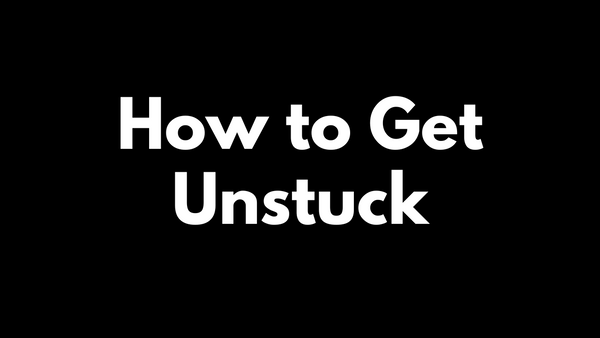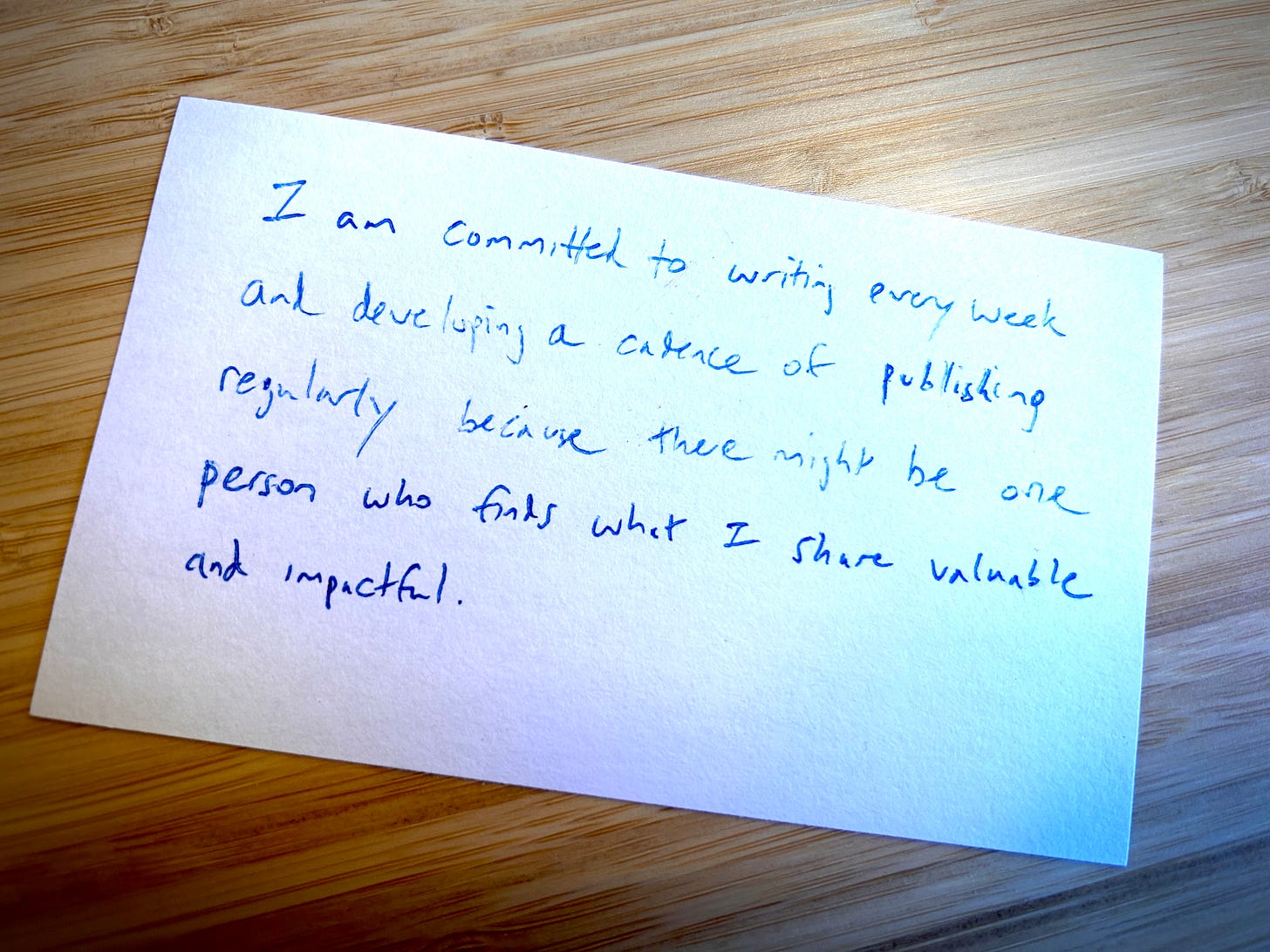
A Case Study on Moving Forward When You're Stuck
Starting and sticking with a newsletter has been on my to-do list for quite some time now.
And if you’re reading this then at some point you entered your email somewhere expecting regular updates from me. You haven’t gotten them.
I could trot out a series of reasons for this. I’ve been busy. Clients take precedence. It’s the kids’ summer vacation. I haven’t felt clear on what to write. Other projects deserved my attention.
These are all partial truths.
But really I’ve felt scared and stuck.
—
We’ve all been there. Unable to move forward, not sure why. We become stranded in a strange cocktail of self-judgment (why is this so hard for me), procrastination (maybe tomorrow I’ll feel clearer), and the risk of never doing things that we feel called to do. There are more enjoyable libations. 🍹
Today I’m going to use my own stuckness in publishing this first issue as a live case study. A sort of blueprint for how to get unstuck so you can hit your own “Publish” button on whatever might be in your way.
Stuckness Results From Competing Commitments
When you struggle to move forward it’s because you have commitments that have come into competition.
The path forward is finding a way to honor them all.
Here’s how, step by step:
Step 1: Name the primary commitment
Start with the change that you are seeking to make in your life. Get in touch with the commitment and why it’s important to you. Write it down.
Here’s mine:
I am committed to sharing my knowledge with more people.
Coaching leaders in organizations ranging from scale to solo founders has given me incredible access to spot the recurring obstacles that individuals, teams, and companies face. I’ve also read hundreds of books and experimented with approaches on how to overcome those obstacles. All of this knowledge is assembled for me in an information capture system (thank you Building a Second Brain) that I can tap into decades of this wisdom.
Even in writing that out, I notice my energy shifting and leaning toward action.
But willpower isn’t the currency of change.
We need to dig deeper than that.
Step 2: What are you doing, or not doing, toward that commitment?
Next, identify the behaviors that are currently playing out around that commitment. Often a mix of what you’re doing and not doing.
My current behaviors related to writing:
Generating many, many (too many?) ideas for newsletters and articles. I am actually quite exceptional at this first step in my creative process, I realize.
Then when I try to combine these ideas into a complete piece of content, I slow down. I worry it’s not good enough, not clear enough, and often wish I had other ideas published that I could reference in the current piece. I stall out or get bored and jump back to a different idea.
I certainly don’t push the Publish button.
Write your current behaviors down and next, we’ll understand what’s beneath them…
Step 3: What assumption is driving the undesired behaviors?
All behavior is built atop assumptions that form our belief system. Most of the time this belief-to-behavior connection serves us without any need for deeper thought.
For example, I brush my teeth every night because I believe it is good for me. I read to my kids at night because I believe a love of books is fundamental to being a life-long learner. I don’t question these beliefs, nor do I feel the need to.
But when we’re stuck, we have a belief in the form of an assumption that is creating another competing commitment.
Now we need to identify the assumption. This is a belief either about yourself or about the world - that creates the foundation for the current undesired behaviors that you just wrote down.
For me, the assumption is:
That my writing and thinking isn’t good enough. That I might be laughed at and need to find assurance, even perfection, before I publish.
This assumption makes every piece of content that I create feel high-stakes. There’s no room for learning, experimentation, nor much joy in the process.
This commitment doesn't serve me or my goals.
I want to choose something different…here’s how…
Step 4: Move from Powerless to Powerful
First off, this story of not being good enough is a familiar one for me. I felt inadequate and laughed at when I was younger. To stay safe I did my best to blend in. And publishing content is a poor way of blending in.
This is why I feel stuck. Writing feels unsafe.
—
But our beliefs aren’t fixed. We can change them by consciously choosing to shift from a mindset of powerlessness (I am at risk, paralyzed by fear) to powerful (I am in action, making the right choice for me).
This shift is enabled by naming a new empowering belief that serves you and your goals.
The new belief that I am choosing to adopt:
There might be one person that gets my newsletter, who might find what I share valuable. It is possible that you, as you read this, now have a recipe for getting unstuck on that project that you've been considering. And perhaps that project might change another person's life.
This belief makes clicking Publish an act of service. Something that I need and want to do. For others and for myself. A chance to share, a chance to learn, a chance to have an impact.
Write down your new, empowering belief that serves you and your goals.
Step 5: Put the new belief into practice
Naming the new belief is the start of change but it isn’t the change. Our body and brain need to experience the positive impact of this new belief. This happens through deliberate practice.
Identify new actions aligned with the belief. And by practicing these actions you’ll strengthen the neural pathways of this new belief. You are changing your brain’s operating system. First with a choice, then with action.
For me, I am committed to:
Writing every week and developing a cadence of publishing on the regular.
It can be helpful also to combine this action statement with your belief and keep this close by to help summon the empowered action.
The structure to use is:
“I am committed to (Action) because (new empowering belief).”
Here’s mine, which sits on my desk as a reminder:

When I sit down to write, I read this note card.
By doing so, I am presencing the new belief in my awareness. The fear of the old assumption is still lurking in the background, but this new idea of what I'm up to and why has more energy and that's all I need. The words help me make new choices.
With any behavior change, accountability is key to breaking free of the old pattern.
I use an Action Coaching Team to help me. Every eight weeks I commit to specific outcomes (e.g. publish four times) and within those eight weeks, every week I commit to specific actions (e.g. write for 25 min 3x) and have a coach who ensures I get it done.
If that’s a step too structured, tap a friend or partner to share the new belief that you’re practicing and the actions that you
Do whatever it takes to keep the new belief in front of you through practice. If these new actions serve you, you’ll notice the friction of the effort fades.
For further exploration:
- While it’s not where I first encountered this framework for getting unstuck, apparently it is from Robert Kegan and Lisa Laskow Lahey’s book Immunity to Change.
- Carol S. Dweck’s book, Mindset, covers more of the Powerless to Powerful shift naming these fixed vs. growth mindset.
- Action Coaching Teams